How to Grow and Care for Houseplants
I am new to caring for houseplants. Can you tell me some basic things to do so I don’t kill my plants?
Hi Sandy
LEARNING HOW TO GROW AND CARE FOR HOUSEPLANTS is a little like cooking 101. We can all agree that anyone with a pot can boil an egg or with a can opener is able to open a can of soup. But only truly dedicated bakers, mindful of every detail, can bake the perfectly flaky apple pie. This article is all about the hard-boiled eggs and canned soups of houseplants—nothing fancy, just simple easy rules to follow that will help you care for your houseplants.
Don’t Overwater
The reason most houseplants die is because they are over watered. When in doubt, don’t water! If the soil is always wet, the roots start to rot and die. We all know that the roots absorb water for the plant, but they also absorb the oxygen that a plant needs. Wet soil prevents air pockets from forming. If there are not enough air pockets, the plant literally has trouble breathing. Succulent plants store water in their thick leaves and stems and should be watered less often than thin-leafed plants.

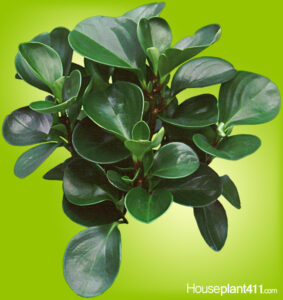
Thin leafed Arrowhead plant- more water Thick leafed peperomia – less water
Don’t Overfertilize
It’s better to starve your houseplants with too little plant food than to force-feed them with too much. Excess fertilizer builds up in the soil, burns the roots, and is the main cause of brown leaf tips. Most plants do not need to be fed in late fall and winter when they are “resting” and not growing. I always recommend diluting the plant food to ½ the recommended strength.
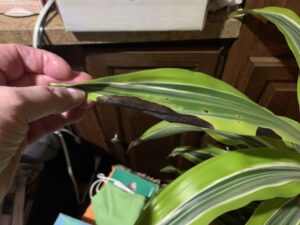
Avoid Using Water that has a Great Deal of Salt or Chemicals
Too much salt in the soil causes brown leaf tips and leaf spots. Never use water that has passed through a softener. It is too salty. Too much fluorine or chlorine in the water also causes brown leaf tips and spots, especially on dracaenas and calathea plants. If your water has a lot of chemicals in it, allow it to sit out overnight before using it. Distilled water or rainwater is another option.
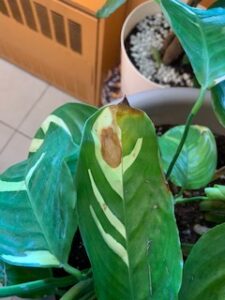
Calathea plant damaged by poor water quality
Don’t Rush to Repot
Avoid the urge to move plants to larger pots. Most plants like to be a little rootbound; this allows the soil to dry out quickly and prevents root rot. I like to wait until the root ball has taken on the shape of the pot before I repot. When repotting, always use the next size pot and nothing larger. The new pot should be only 1”-2” larger than the root ball of the plant. There must be drip holes in the bottom of the container so excess water can drain out. When you purchase a new plant, do not repot it for at least six weeks. The plant needs time to acclimate to its new surroundings and being repotted is quite a shock.
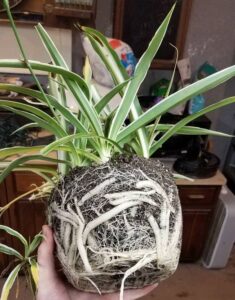
Time to repot the spider plant
Prune Your Plants Aggressively
Pruning a plant keeps it full and bushy, and you can use the cuttings to start new plants. Immediately remove dead or dying flowers as soon as they appear.
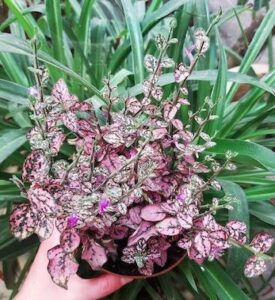
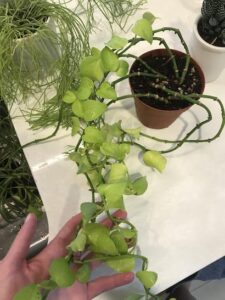
Pink Splash needs pruning Bare Pothos vines need to be cut off
No Direct Sun
There are very few houseplants that can handle direct sun without getting ugly brown marks on their leaves and having their flowers quickly fade.
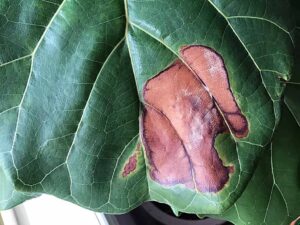
Fiddle leaf Fig burned by the sun
Examine Your Plants Frequently
It’s easier to prevent a serious pest or disease problem than to treat it. Examine your plants every time you water. Check for unusual marks or discoloration and keep an eye out for unwanted visitors crawling where they don’t belong. Dry leaves and good air circulation help prevent plant diseases.
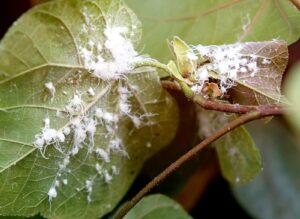
Mealy Bugs on plant leaves
Keep Poisonous Plants Out of Reach
Many common houseplants are poisonous and have a toxicity level you should be aware of. Levels: #1- Plant may cause minor problems if ingested or if the sap gets on your skin. #2- Plant is moderately to highly toxic, stomach issues, skin irritations, breathing problems can occur. #3- Plant is very, very poisonous; if eaten, especially in large quantities, it may result in severe stomach problems, severe skin irritations, and severe breathing difficulties. #4- plant is so dangerous that eating even a small piece can be life threatening to a small child or pet. Keep this number for the Poison Control Center easily available in case of an emergency: 1-800-222-1222.
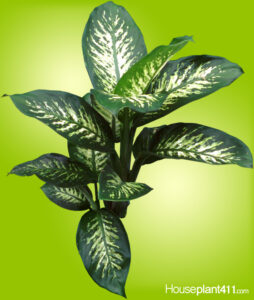
Dieffenbachia is VERY poisonous
Think Twice Before Asking Friends and Relatives to Care for Your Plants
When friends and relatives care for your plants, they often kill them with kindness. If you are going away for a few weeks, water well before you leave and move your plants to a cool, low-light area. Your plants may be droopy when you return, but they’ll perk up once you water.
